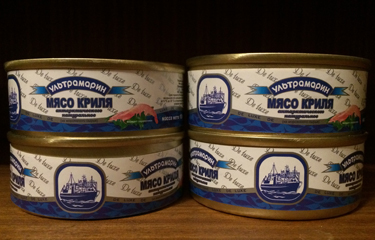Russian government officials have set their sights on expansion into the Antarctic krill fishery as part of a national strategy to increase domestic seafood production.
Growing Russia’s krill catch is a significant part of a strategy crafted by Ilya Shestakov, chairman of the Russia’s Federal Agency for Fisheries, to reach the country’s goal of doubling the country’s revenues from seafood exports. Recently, the agency’s representatives have begun promotion of the concept in Russian media and at industry events.
“We see that there is enough stock of krill,” Pyotr Savchuk, executive chairman of the agency, said in March 2020 at an appearance before the Federation Council, the Upper Chamber of the Russian Parliament.
To make the idea work, Savchuk said new specialized ships for fishing krill will have to be built, in addition to state-of-the-art shore processing facilities. But krill's high levels of omega-3s, vitamins, and other healthful fatty acids make it very attractive as a resource for applications in food, aquaculture, pharmacology, and nutraceutical products, Savchuk said.
“We understand that’s a rather expensive project, it’s worth nearly RUB 45 billion [USD 640 million, EUR 576 million],” he said. “Despite this sum, businesses are expressing interest in krill.”
The first practical step toward the implementation of the initiative took place in early May 2020, at the completion of a five-month long krill expedition by AtlantNIRO. A dozen specialists studied krill habitat in the Antarctic, its stocks, sizes, and other information to help them put together a detailed report on the fishery’s potential. As part of that report – ordered by Shestakov – the scientists will provide their recommendations for how Russian vessels can engage in economically effective fishing for Antarctic krill.
“It’s necessary to work out a model of profitable fishing,” Shestakov said. “The data collected during the research works will allow us to organize fishing in the Atlantic part of the Antarctic.”
That data was promising, according to Vladimir Shnar, a senior researcher at AtlantNIRO and the expedition’s chief. Shnar said stocks of krill in the area of the expedition were estimated to be in the range of 60 million MT, much higher than they were 17 years ago, the last time they were surveyed by Russian scientists.
An open resource
Krill’s value as a commercial species is not solely in its abundance of nutrients, but also in its location in the Atlantic part of the Antarctic, which falls under the governance of the United Nations’ Commission for the Conservation of Antarctic Marine Living Resources (CCAMLR). As a CCAMLR member, Russia is eligible to fish in the area.
“It’s one of the few marine resources that’s freely accessible thanks to its being beyond anyone’s [exclusive] fishery zones,” Konstantin Bandurin, head of the Atlantic branch of the Russian Federal Research Institute of Fisheries and Oceanography (AtlantNIRO) said recently at a press conference on the topic.
According to AtlantNIRO, the Soviet Union was a pioneer in the development of the Antarctic krill fishing. Through the mid-1980s through the early 1990s, the USSR harvested between 300,000 and 360,000 metric tons (MT) of krill in Antarctic waters. The country’s fishing effort reached its zenith in 1982, when the USSR caught 93 percent, or 491,700 metric tons (MT) of the 528,700 MT of krill caught that year. But after the collapse of the Soviet Union, its total catch sunk to 90,000 to 120,000 MT. Russia has not been active in krill fishing since 2010, when it pulled in a modest 17,700 MT catch total.
However, the fishery began attracting international attention in the mid-2000s, with growing interest from Norwegian and Chinese fisheries. Last year, 13 ships from China, Norway, South Korea, Ukraine, and Chile were active in the fishery, catching a combined 313,000 MT.
While a precautionary catch limit for the fishery has been set at 5.61 million MT, currently, CCAMLR has a more restrictive limit of 620,000 MT to ensure stock depletion does not occur, as krill have been designated a keystone species for the Antarctic ecosystem, with penguins, whales, and seals all dependent on krill for survival.
But Russian officials say that even at CCAMLR’s lower threshold, there is room for Russian expansion into the fishery.
But first, Russia must expand its presence in the region, according to Bandurin. Upon the scientific expedition’s return to Russia, Bandurin praised Russia’s reentrance into the fishery it had abandoned a decade ago.
“We have returned to the area which we had long been absent to. We have demonstrated our flag in this very remote part [of the world]," commented Konstantin Bandurin on the political outcome of the expedition.
Business push pause
While some of Russia’s highest-ranked officials are eagerly promoting their krill plan, Russian fishing companies have been more cautious in their approach. In 2018, during an effort by Russia’s fishery agency to get state funding for building two specialized ships for fishing krill – the initiative was eventually rejected by the Ministry of Finance – representatives of the country’s top fishing companies expressed doubt about the attractiveness of krill as a commercial species.
More recently, in an interview with Kommersant, Norebo Deputy Director Sergey Sennikov said krill fishing can be profitable, provided sufficient quotas are allotted to individual vessels, allowing them to achieve a high level of productivity. But he said in order to be successful, Russia needs to establish a more stable demand and established market for krill products, which Sennikov said does not yet exist.
Recent experiences of foreign companies in the fishery have shown they have struggled significant with margins, as many have struggled to make a profit, Dmitry Ozerskiy, chairman of the board of directors of The North Western Fishery Consortium, told Kommersant. Ozerskiy said there are other more sought-after species in Russia that remain underutilized, including iwashi (sardine) and mackerel in the Russian Far East.
Savchuk told Kommersant three Russian companies are currently considering entering the Antarctic krill fishery, but he declined to name them.
Photo courtesy of Garijs Polskis/Shutterstock







